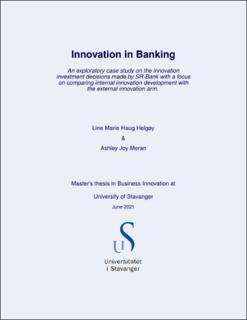| dc.description.abstract | The purpose of this thesis is to answer the question What is most beneficial for SR-Bank; to invest in external innovation and start-ups, or to focus on internal innovation development? Or is it a combination of both?. This thesis evaluates SR-Banks innovation strategy, and focuses on the decisions SR-Bank has made when it comes to investing in their internal innovation lab and innovation team compared to their decisions to invest in innovations through Finstart Nordic. The literature and theories used in this thesis are focused on Innovation, Innovation Strategy, Employee-Driven Innovation, Open Innovation, McKinsey’s Three Horizons of Growth, Maximizing Returns on Innovation, and Fintech. The empirical approach for the study, is an exploratory case study, which was conducted using the qualitative approach. A total of 9 semi-structured in-depth interviews form the basis of the collected primary data. In the data analysis, we find for Employee-Driven Innovation (EDI) that there are improvements to be made in the second and third order, meaning that the management needs to systematize and formalize the innovation processes initiated by the employees (second order), as well as encourage the employees to participate (third order). To facilitate more EDI, the suggestion is to develop a new portal for employees to come up with innovative ideas, implement an open-door policy, inform the employees on new innovation processes earlier in the process, and encourage a larger visibility of those who work in the Strategy, Innovation and Development department. In regards to Open Innovation, the bank should use more of the inside-out type, by allowing externals, such as Finstart Nordic, to utilize their ideas. As for McKinsey’s Three Horizons of Growth, the bank should continue to use their current strategy, meaning that Horizon One should be conducted internally, while Horizon Two and Horizon Three mainly should be conducted externally by FinStart Nordic. Here, Horizon One includes incremental innovation and maintaining the core of the business, Horizon Two includes nurturing current business or emerging business, while Horizon Three includes disruptive innovations or completely new business. The thesis concludes that a combination of both internal innovation development and investment in external innovation and start-ups is the best solution. This combination allows SR-Bank to take advantage of lucrative investing opportunities with companies whose products align with the bank’s needs. It also allows for an internal team to specialize in what they do, and remain committed to both designing the innovation strategy, which leads to what types of innovation start-ups the bank will invest in, and manage the Employee-Driven initiatives internally. | |
